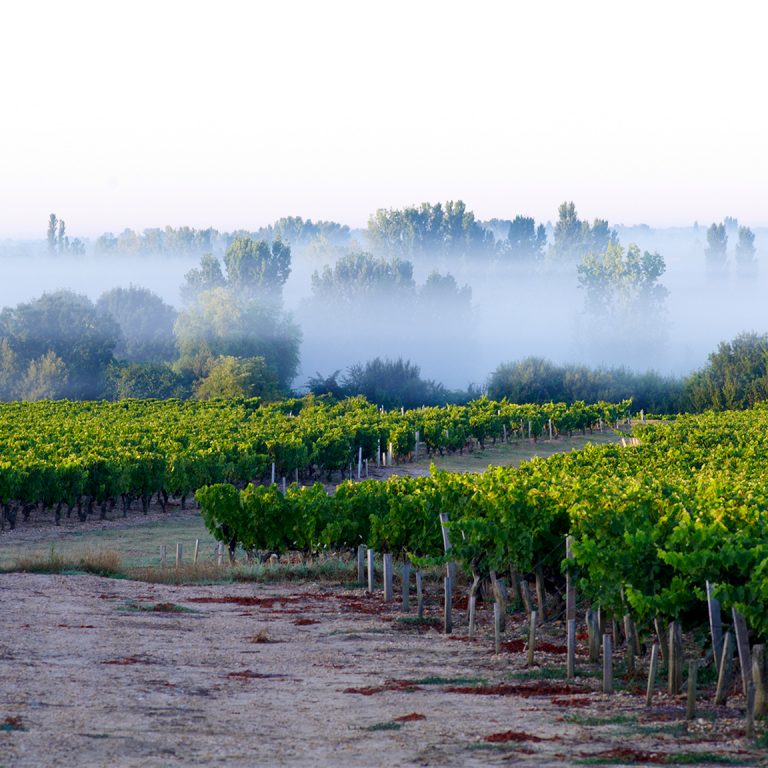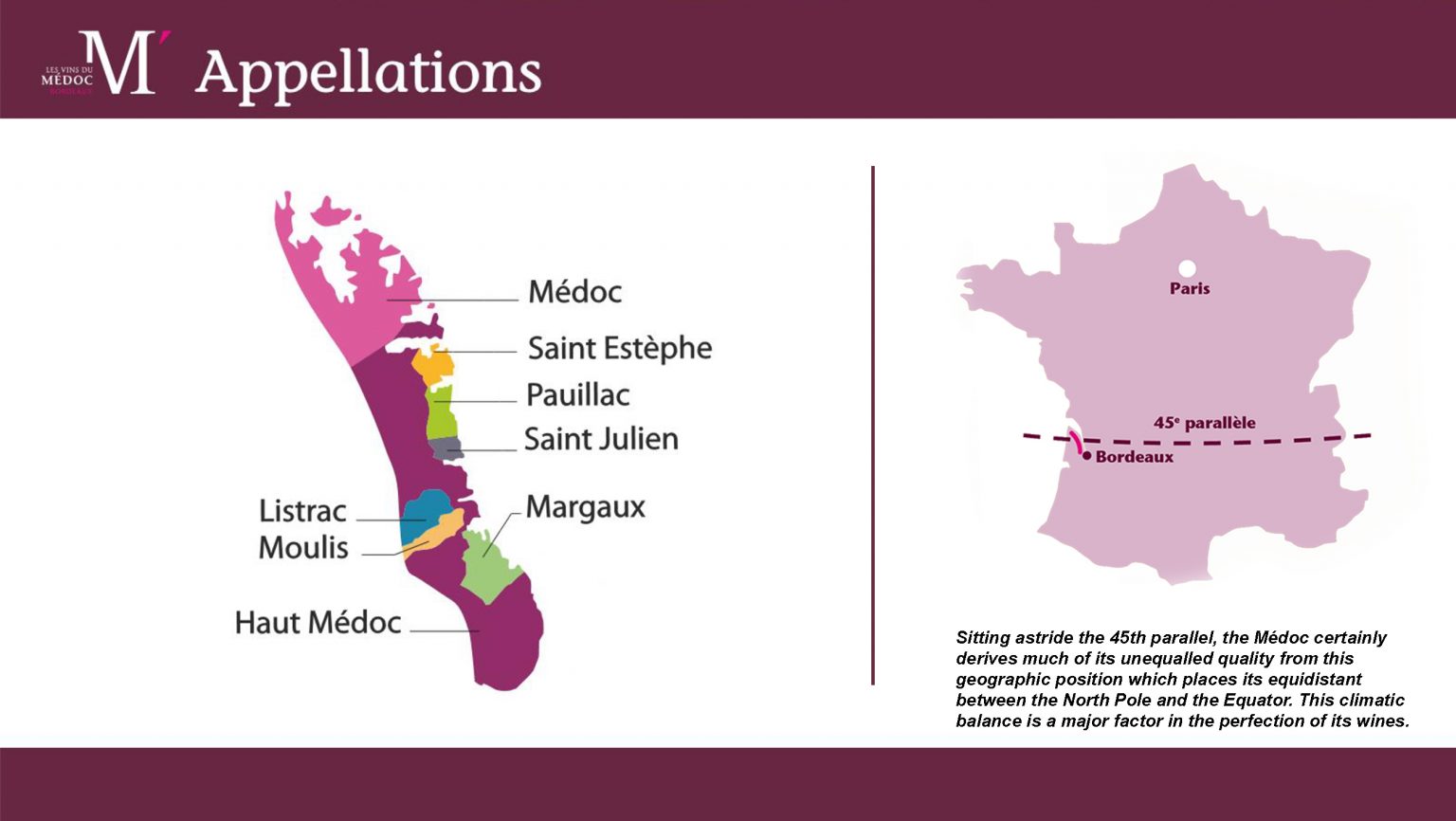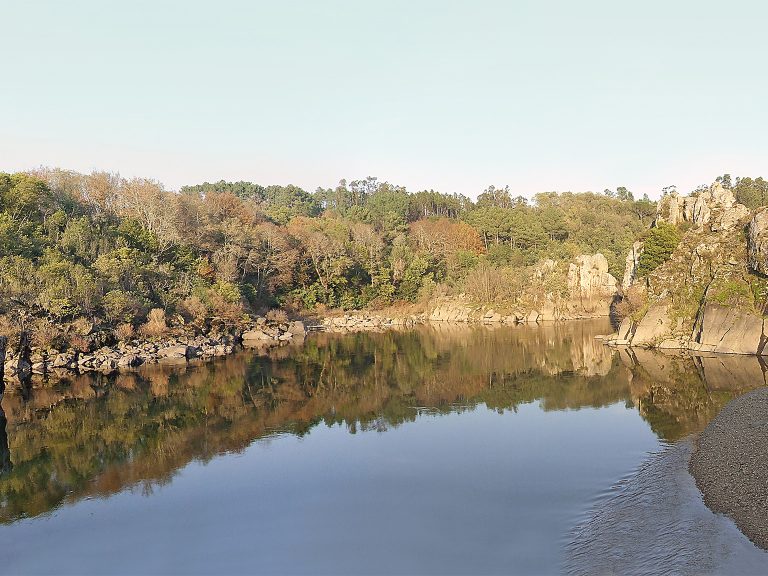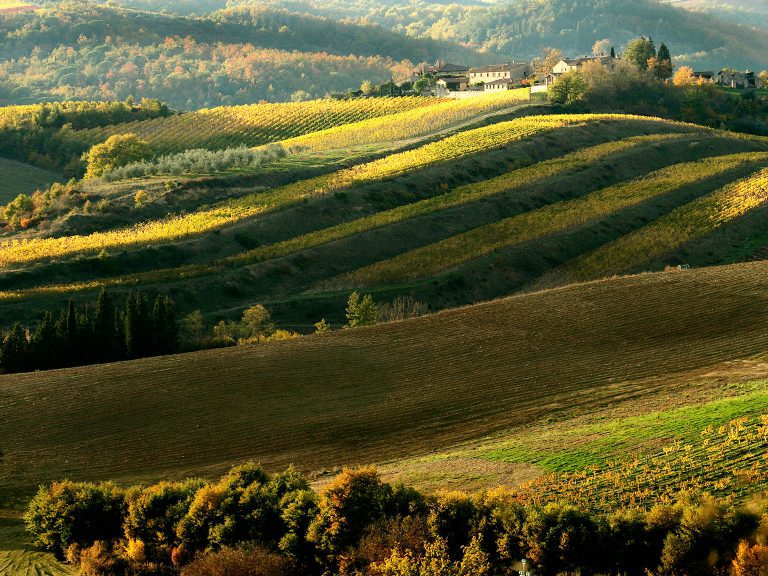This content was produced in collaboration with our partner, Les Vins du Médoc.
Covering 16,000 hectares on the left bank of the Gironde estuary, the Médoc comprises 15 percent of Bordeaux’s vineyards. With a history of making some of the world’s most famous wines, it continues to represent an important part of Bordeaux in both domestic and export markets; the Médoc sells almost 100 million bottles per year, half of which are exported.
But while super-serious wine aficionados can rattle off the names of the Médoc’s classified growths in their sleep, there are many other pockets of the region that remain overlooked by trade and consumers alike. Nearly 1,000 wine brands and 600 châteaus call the Médoc home, and while most vineyards are over 20 hectares in size, the region counts properties of all sizes among its ranks. Médoc wines are made by small, family-owned producers, cooperative cellars, and large groups; estates are helmed by prominent families who established the reputation of Bordeaux over many generations, young, enthusiastic newcomers, and foreign investors.
This dynamic range of individuals and expertise, combined with the Médoc’s diverse soils, topographies, and grape varieties, is serving to drive this classic region forward while building upon the traditions of the past. Take another look at Médoc and discover why this quintessential wine region is better than ever.

Don’t miss the latest drinks industry news and insights. Sign up for our award-winning newsletters and get insider intel, resources, and trends delivered to your inbox every week.
Geography
The vineyards of the Médoc stretch 70 to 80 kilometers from the city of Bordeaux northwest along the Gironde estuary’s left bank, comprising a strip of land just two to five kilometers wide. Situated on a peninsula, it is home to Bordeaux’s mildest and wettest climate, its temperatures moderated by the Atlantic Ocean to the west and the Gironde estuary to the east. Protected from harsh Atlantic winds by pine forests, it is warm and humid with plentiful sun and good air circulation.
The Médoc is known for its outcrops of gravel, famed for their ability to aid Cabernet Sauvignon’s ripening by storing heat and draining excess water, but the region’s soils and their origins are quite complex, formed over millions of years. The older Pyrenees gravel, which was carried by rivers from the Pyrenees mountains, is found to the west, while Garonnais gravel, which was formed by the increase in water levels of the Garonne and Dordogne rivers, is found along the estuary to the east. Between these strips of gravel is richer and cooler clay-limestone.
Over the centuries, vintners have made painstaking efforts to study and understand their specific soil types and the wines that result from them. This careful attention to terroir specificity and optimal grapevine plantings is one of the reasons why the Médoc has been able to maintain a reputation for excellence throughout its history.
History
While the Médoc has shaped the history of global winemaking, ironically, much of the Médoc’s most significant wine history has taken place relatively recently. Pockets of vines were planted in the Médoc in the 14th century, from Blanquefort, just outside the city of Bordeaux, to Margaux and Pauillac. Members of Bordeaux parliament and traders from the city created the first Médoc properties in the 16th century and then invested in the best gravel parcels at the beginning of the 17th century.
The arrival of the Dutch propelled the Médoc forward as they drained the peninsula’s marshes in the mid-17th century, resulting in more land suited for viticulture, and improved local techniques in the vineyard and cellar. This also prompted an important legacy of technology and innovation in the Médoc—one that today’s estates continue to push forward.
By the mid-18th century, châteaus practiced stricter selection in the vineyard and introduced the concept of both first wines, or grands vins, and second wines, while the first négociants perfected cellar aging practices. By 1760, almost all of the Médoc’s vineyards were established after massive investments from Bordeaux nobility, which then ushered in a century of quality investment, the establishment of Grand Cru châteaus, and international recognition. Upon the request of Napoleon III, the 1855 Classification officially recognized the hierarchy of these 60 classified Grands Cru châteaus.
However, the late 19th and early 20th centuries set a number of challenges upon the Médoc. Powdery mildew and phylloxera decimated vineyards towards the end of the 19th century, followed by two world wars and global economic crises. By the end of the 1950s, just 6,000 hectares of the Médoc were planted to vine, a mere fraction of the 25,000 hectares planted in the late 1800s.
Happily, the second half of the 20th century resulted in a renaissance for the Médoc, with reconstructed vineyards, innovation, and a renewed focus on quality. The Médoc’s excellence was once again proclaimed around the world when Robert M. Parker Jr. praised the 1982 vintage, resulting in unprecedented attention for these legendary wines.
Key Appellations
There is a huge range of wines produced within the eight AOCs of the Médoc, ranging from the world’s most expensive, luxury bottles to affordable wines suited for everyday drinking. Many Médoc wines are priced between $15 and $30.
While white grapes may be planted in the boundaries of the Médoc and labeled as Bordeaux Blanc, all of Médoc’s AOCs only permit the production of red wines. Merlot is slightly more dominant in the sub-regional appellations of Médoc AOC and Haut-Médoc AOC, as well as Listrac and Moulis, while Cabernet Sauvignon is slightly more planted in the appellations of Pauillac, Margaux, Saint-Estèphe, and Saint-Julien.
Médoc AOC
The Médoc AOC is the largest appellation on the Médoc peninsula, comprising 34 percent of vineyards and located north of the Haut-Médoc. Many small estates are located here, and 25 percent of Médoc AOC production is made by cooperative cellars. Its soil is varied, comprising all of the region’s major soil types, creating a wide range of wine styles from full and complex to fresh and easy-drinking.
Haut-Médoc AOC
Representing 27 percent of the Médoc’s vineyards, the Haut-Médoc produces the greatest variety of wines in the region due to the many soils and topographies it covers. It has more gravel than the Médoc AOC and is home to many of the members of the Crus Bourgeois.
Listrac AOC
Listrac’s vineyards are the highest in the Médoc, situated between Moulis and Saint-Julien. With gravel outcrops to the east and west and a plateau of limestone, this relatively cooler area creates wines that match lively acidity with full body.
Moulis AOC
The smallest of Médoc’s appellations, Moulis lies between the main road leading into the peninsula, situated just south of Listrac. Its vineyards are set among rolling hills and have varied soils, creating an intriguing range of charming and generous wines that offer good value.
Margaux AOC
The largest and southernmost of the Médoc’s communal AOCs, five individual communes can label their wines as Margaux AOC. It’s revered for creating high-quality wines, and indeed, two-thirds of the properties in Margaux are classed growths. High proportions of Garonnais gravel are found here, mixed with pebbles and situated over a subsoil of limestone and clay in certain exceptional parcels. The wines tend to be elegant and ethereal, with the potential to age for decades.
Pauillac AOC
The vineyards of Pauillac have a front-row seat to the Gironde estuary, their poor gravel soils particularly well-suited to creating powerful and long-lived wines. It is home to more classed growths than any other AOC, and Cabernet Sauvignon is particularly important to Pauillac wines.
Saint-Estèphe AOC
Home to many different types and sizes of estates, brands, and co-ops, Saint-Estèphe has layers of gravel, sand, and clay over a subsoil of limestone. It’s known for producing deeply-colored and full-bodied wines that age exceptionally well.
Saint-Julien AOC
While Saint-Julien is home to fewer individual classed growths, it can boast of the highest concentration of Crus Classés in the Médoc, comprising 87 percent of the AOC’s production. The soils are homogeneously gravelly, creating fine and elegant wines with balance, subtlety, and reliability.
Classifications
Though the Médoc is home to many different sizes and structures of producers, it is well-known for its prevalence of prestigious estates called crus. Several classifications and families have been established to recognize these crus over the Médoc’s history.
Grands Crus Classés en 1855 (1855 Classification)
This famous classification was created in 1855 to recognize 60 Grands Crus set within five tiers of growths. Despite over 150 years of history, these elite châteaus remain world-renowned standard-bearers of quality and excellence today, maintaining their reputation by innovating and pushing the region forward. The Grands Crus Classés represent 22 percent of Médoc vineyards.
Crus Bourgeois
First introduced in 1932, these crus are the heart of the Médoc, representing 30 percent of the region’s production. A set of regulations establishes quality criteria and the crus are reviewed and updated regularly. Currently there are 249 members of the Crus Bourgeois.
Crus Artisans
While the term “Cru Artisan” has a long history in the Médoc, this classification was established in 2017. It is meant to signify small, family estates who craft wines from the vineyard all the way through to sales and marketing, resulting in distinctly personal wine character. There are 33 Crus Artisans, representing two percent of Médoc vineyards.
Key Grape Varieties
Médoc’s tradition of blending has become a global standard, prompting regions around the world to create their own iterations of the classic “Bordeaux blend.” Blending allows Médoc vintners to achieve perfect balance while also ensuring good quality wine from vintage to vintage. By devoting attention to its specific terroir, each estate uses its own assemblage not only to express the vineyard, but to express its individual identity, know-how, and tradition.
The four key varieties of the Médoc, built upon the cornerstones of Cabernet Sauvignon and Merlot, have established the region’s reputation for full-bodied, powerful wines built for long aging. However, this mosaic of grape varieties, soils, and microclimates creates stylistic diversity, meaning the region is also home to aromatic, elegant, delicate wines that can be enjoyed younger.
Cabernet Sauvignon
Cabernet Sauvignon is king in the Médoc, as it is well-suited to the region’s gravel soils. It is known for its tannins and acidity, creating the structure that is a key ingredient of age-worthy wines. Cabernet Sauvignon also contributes complex aromas and flavors of blackcurrant and spice to blends.
Merlot
The second-most popular grape in the Médoc, Merlot has more plantings on this side of the Gironde than many realize. It is the earliest-ripening grape in the Médoc and is often planted in cooler, clay-limestone soils. Merlot brings soft texture, round fruit, and body to Médoc wines.
Cabernet Franc
Though it is not as prominent in the Médoc as Cabernet Sauvignon and Merlot, Cabernet Franc thrives in clay-limestone soils. It adds fresh raspberry, floral, and spicy aromas to a blend and contributes supple tannic structure, particularly in wines with lower proportions of Cabernet Sauvignon.
Petit Verdot
A notoriously late-ripening variety, Petit Verdot is not widely grown in the Médoc. However, even when it is used in small proportions, the grape lends full body and deep color to a Médoc blend, along with black fruit and floral aromas.
What is Happening in Médoc Today?
As it has been throughout its history, modern Médoc is at the forefront of technology in both vineyard and cellar. Proprietors are careful to place significant investment in the latest innovations in order to maintain the region’s reputation for excellence, always pushing themselves with an eye towards the future.
Much of this forward-thinking energy is being driven by the Médoc’s smaller producers and the newest generations of established, historical estates. These young proprietors and winemakers are bringing a global perspective to the region’s classic wines, broadening Médoc wine styles to appeal to a wider range of consumers. Increasingly, women are taking over the helm of Médoc’s wine estates, bringing new and fresh perspectives.
Sustainability has also been top-of-mind for Médoc producers, and the region is working to amend AOC regulations to make sustainability and biodiversity practices mandatory. Year-over-year, the region has been making strides towards its sustainability goal, with 60 percent of all Bordeaux vineyards certified by an environmental process in 2017. By taking actions towards reducing pesticide use, preserving biodiversity, and managing the region’s carbon footprint, the Médoc is planning to pave the way for sustainability both now and in the future.









